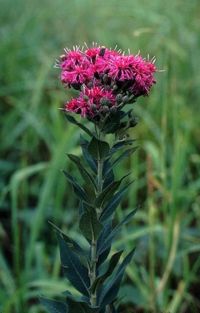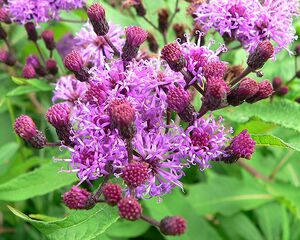Vernonia
| subsp. var. | ||||||||||||||||||||||||||||||||||||||||||||||||||||||||
|---|---|---|---|---|---|---|---|---|---|---|---|---|---|---|---|---|---|---|---|---|---|---|---|---|---|---|---|---|---|---|---|---|---|---|---|---|---|---|---|---|---|---|---|---|---|---|---|---|---|---|---|---|---|---|---|---|

|
|
| ||||||||||||||||||||||||||||||||||||||||||||||||||||||
| ||||||||||||||||||||||||||||||||||||||||||||||||||||||||
| Standard Cyclopedia of Horticulture |
|---|
|
Vernonia (after Wm. Vernon, an English botanist who traveled in North America). Compositae. Iron-weed. Perennial herbs or in the tropics shrubs and trees. Leaves alternate, pinnately veined: fls. usually purple or rose, borne in the following species in terminal cymes: heads not glomerate, several to many exclusively tubular-fid.: involucre of dry or partly herbaceous, much-imbricated bracts: corolla regularly 5-cleft into narrow lobes: achenes 8-10-ribbed, with a blunt apex and a cartilaginous, callous base; pappus double (at least in American species).—About 560 species widely scattered about the world, but is possibly most plentiful in S. Amer. The latest monograph is that by H. A. Gleason in Bull. N. Y. Bot. Gard. 4:144-243, 1906. The following species are native of the U. S., and are hardy perennial herbs of attractive appearance, with rather large heads of purple fls. in terminal clusters in late summer or early fall. Vernonias are of easy cult. in any good, rich border, being easily prop. by division. Very satisfactory groupings can be made with vernonias and native asters and goldenrods. V. Arechavaletae, Andre. Glabrous shrub, 3-6 ft. high: lvs. sessile, leathery, linear-lanceolate: fl.-heads reddish violet. Uruguay. —V. gigantea. Hort. Robust: fl. -heads in panicles, carmine or violet-rose.
|
| Vernonia {{{status}}} Fossil range: {{{fossil_range}}}
| ||||||||||||||||||||||||||||||||||||||||||||||||||||||||||||||||||
|---|---|---|---|---|---|---|---|---|---|---|---|---|---|---|---|---|---|---|---|---|---|---|---|---|---|---|---|---|---|---|---|---|---|---|---|---|---|---|---|---|---|---|---|---|---|---|---|---|---|---|---|---|---|---|---|---|---|---|---|---|---|---|---|---|---|---|
 Vernonia baldwinii | ||||||||||||||||||||||||||||||||||||||||||||||||||||||||||||||||||
| Plant Info | ||||||||||||||||||||||||||||||||||||||||||||||||||||||||||||||||||
| ||||||||||||||||||||||||||||||||||||||||||||||||||||||||||||||||||
| Scientific classification | ||||||||||||||||||||||||||||||||||||||||||||||||||||||||||||||||||
| ||||||||||||||||||||||||||||||||||||||||||||||||||||||||||||||||||
| [[{{{diversity_link}}}|Diversity]] | ||||||||||||||||||||||||||||||||||||||||||||||||||||||||||||||||||
| {{{diversity}}} | ||||||||||||||||||||||||||||||||||||||||||||||||||||||||||||||||||
| Binomial name | ||||||||||||||||||||||||||||||||||||||||||||||||||||||||||||||||||
| {{{binomial}}} | ||||||||||||||||||||||||||||||||||||||||||||||||||||||||||||||||||
| Trinomial name | ||||||||||||||||||||||||||||||||||||||||||||||||||||||||||||||||||
| {{{trinomial}}} | ||||||||||||||||||||||||||||||||||||||||||||||||||||||||||||||||||
| Type Species | ||||||||||||||||||||||||||||||||||||||||||||||||||||||||||||||||||
| {{{type_species}}} | ||||||||||||||||||||||||||||||||||||||||||||||||||||||||||||||||||
| Species | ||||||||||||||||||||||||||||||||||||||||||||||||||||||||||||||||||
| About 1000; see text | ||||||||||||||||||||||||||||||||||||||||||||||||||||||||||||||||||
| [[Image:{{{range_map}}}|{{{range_map_width}}}|]] | ||||||||||||||||||||||||||||||||||||||||||||||||||||||||||||||||||
| Synonyms | ||||||||||||||||||||||||||||||||||||||||||||||||||||||||||||||||||
| {{{synonyms}}} |
Vernonia is a genus of about 1000 species of forbs and shrubs in the family Asteraceae. Some species are sometimes known as ironweeds. Some species are edible and of economic value. They are known for having intense purple flowers. The genus is named for English botanist William Vernon. There are numerous distinct subgenra and subsections in this genus. This has lead some botanists to divided this large genus into smaller groups which separate the species into distinct genra. For instance, the Flora of North America only recognizes about 20 species, 17 of which are in North America or n. Mexico, with the other two or three being found in South America.[1]
Uses
Several species of Vernonia, including V. calvoana, V. amygdalina, and V. colorata, are eaten as leaf vegetables. Common names for these species include bitterleaf, ewuro, and ndole. They are common in most West African and Central African countries. They are one of the most widely consumed leaf vegetables of Cameroon, where they are a key ingredient of ndole stew. The leaves have a sweet and bitter taste. They are sold fresh or dried, and are a typical ingredient in egusi soup.
V. amygdalina is well known as a medicinal plant with several uses attributed to it, including for diabetes, fever reduction, and recently a non-pharmaceutical solution to persistent fever, headache, and joint pain associated with AIDS (an infusion of the plant is taken as needed).[2][3] These leaves are exported from several African countries and can be purchased inexpensively in grocery stores aiming to serve African clients for about $1.50/225gm pkg. frozen. The roots of V. amygdalina have been used for gingivitis and toothache due to its proven antimicrobial activity.[4]
V. galamensis is used as an oilseed in East Africa.
Vernonia species are used as food plants by the larvae of some Lepidoptera species including Coleophora vernoniaeella (which feeds exclusively on the genus) and Schinia regia (which feeds exclusively on V. texana).
Species

Species of this genus are found in South America, Africa, s.e. Asia, and North America. Vernonia species are well known for hybridizing between similar species in areas of overlapping ranges. There are approximately 1000 species of Vernonia, a partial species list is given below. Click here for a full species list.
North America
- Vernonia acaulis
- Vernonia altissima
- Vernonia arkansana
- Vernonia angustifolia
- Vernonia baldwinii
- Vernonia blodgettii
- Vernonia fasciculata
- Vernonia flaccidifolia
- Vernonia gigantea
- Vernonia glauca
- Vernonia larseniae
- Vernonia lettermannii
- Vernonia lindheimeri
- Vernonia marginata
- Vernonia missurica
- Vernonia noveboracensis
- Vernonia pulchella
- Vernonia texana
Africa
See also
External links
- "Vernonia Information System". Arid Land Agricultural Research Center. Retrieved on 2006-09-10.
- "Crop fact sheet for V. galamensis". Purdue University Center for New Crops and Plant Products. Retrieved on 2006-09-10.
- "Effect of Processing and Preservation Methods on Vitamin C and Total Carotenoid Levels of some Vernonia (Bitter Leaf) Species". Retrieved on 2006-09-10.
References
- ↑ Flora of North America: Vernonia
- ↑ Herbal medicine--its use in treating some symptoms of AIDS; 9th International AIDS Conference
- ↑ Report:INDIGENOUS APPROACHES TO THE HIV/AIDS SCOURGE IN UGANDA, Chap. 5
- ↑ TRADITIONAL MEDICINE DEVELOPMENT FOR MEDICAL AND DENTAL PRIMARY HEALTH CARE DELIVERY SYSTEM IN AFRICA. African Journal of Traditional, Complementary and Alternative Medicines. Vol. 2, Num. 1, 2005, pp. 46-61